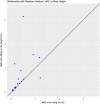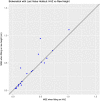Comparing predictive abilities of longitudinal child growth models
- PMID: 30094965
- PMCID: PMC6767565
- DOI: 10.1002/sim.7693
Comparing predictive abilities of longitudinal child growth models
Abstract
The Bill and Melinda Gates Foundation's Healthy Birth, Growth and Development knowledge integration project aims to improve the overall health and well-being of children across the world. The project aims to integrate information from multiple child growth studies to allow health professionals and policy makers to make informed decisions about interventions in lower and middle income countries. To achieve this goal, we must first understand the conditions that impact on the growth and development of children, and this requires sensible models for characterising different growth patterns. The contribution of this paper is to provide a quantitative comparison of the predictive abilities of various statistical growth modelling techniques based on a novel leave-one-out validation approach. The majority of existing studies have used raw growth data for modelling, but we show that fitting models to standardised data provide more accurate estimation and prediction. Our work is illustrated with an example from a study into child development in a middle income country in South America.
Keywords: child development; growth curve; trajectory.
© 2018 John Wiley & Sons, Ltd.
Figures




Comment in
-
Commentary: Methods for calculating growth trajectories and constructing growth centiles.Stat Med. 2019 Aug 30;38(19):3571-3579. doi: 10.1002/sim.8129. Stat Med. 2019. PMID: 31298428 Free PMC article.
-
Response to Professor Tim Cole's commentary: Methods for calculating growth trajectories and constructing growth centiles.Stat Med. 2019 Aug 30;38(19):3584-3585. doi: 10.1002/sim.8127. Stat Med. 2019. PMID: 31298430 No abstract available.
References
-
- Shields B, Wacogne I, Wright C. Weight faltering and failure to thrive in infancy and early childhood. BMJ. 2012;345:e5931. - PubMed
-
- Martorell R, Khan L, Schroeder D. Reversibility of stunting: epidemiologic findings from children in developing countries. Eur J Clin Nutr. 1994;48 (Suppl 1):S45‐S57. - PubMed
-
- Checkley W, Epstein L, Gilman R, Black R, Cabrera L, Sterling C. Effects of Cryptosporidium parvum infection in Peruvian children: growth faltering and subsequent catch‐up growth. Am J Epidemiol. 1998;148:497‐506. - PubMed
-
- Norgan N. Long‐term physiological and economic consequences of growth retardation in children and adolescents. Proc Nutr Soc. 2000;59:245‐256. - PubMed
Publication types
MeSH terms
LinkOut - more resources
Full Text Sources
Other Literature Sources
Medical
